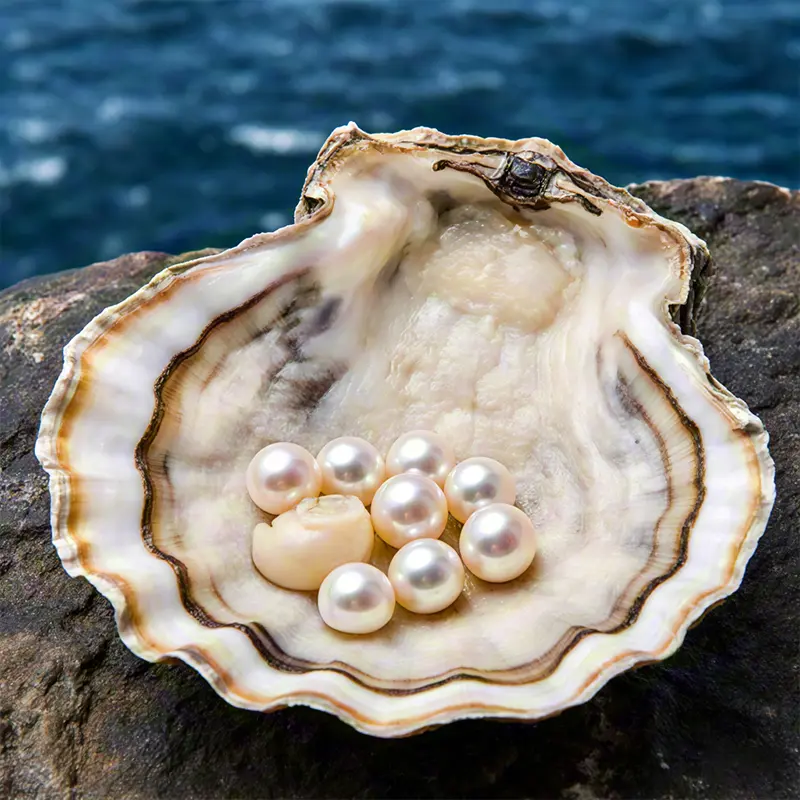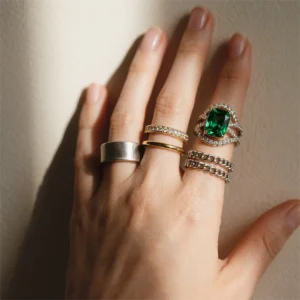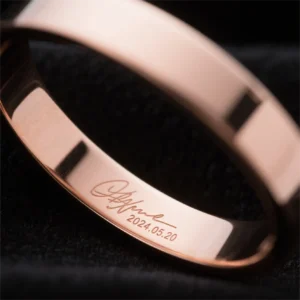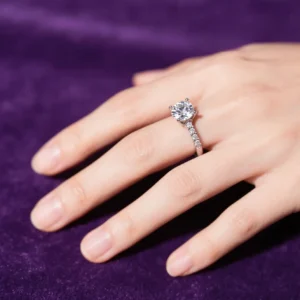Pearls have fascinated people for thousands of years, and the natural lustre of pearls always adds a sense of elegance and luxury to a piece. We understand the importance of mastering pearl knowledge to create exceptional pearl jewelry pieces. In this guide, we will systematically analyse the types of pearls, quality, and maintenance knowledge to help you master the mystery of this natural treasure.
What Are Pearls: How Pearls Are Formed?
Pearls are an ancient organic gemstone, and were one of the most sought-after and favourite jewels of royalty and nobility in ancient times. A pearl is a beautiful, shiny object formed inside a mollusc (such as an oyster or clam). When an irritant enters a mollusc’s shell, such as a grain of sand or a tiny parasite that gets trapped inside the mollusc’s shell, the mollusc begins to produce layers of a special substance called nacre (also known as mother-of-pearl) to protect itself from this discomfort. As the mollusk continues to cover the irritant with these layers over time, they harden and eventually form a shiny pearl, much like the gestation process of a fetus, so pearls also symbolise life, motherhood, and purity.
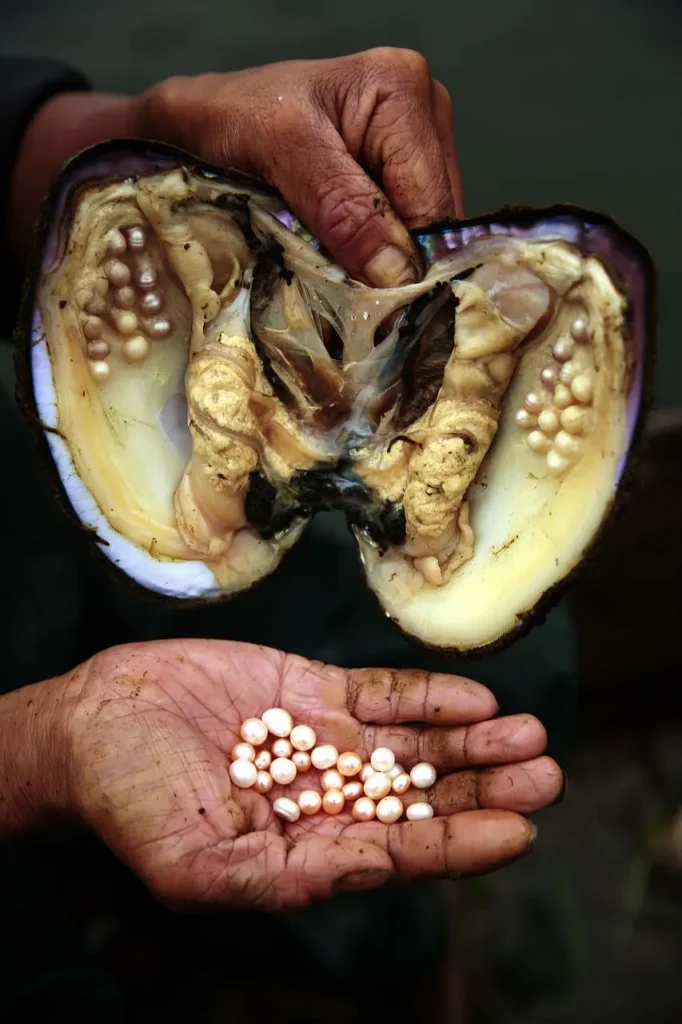
What Is Natural Pearl?
A natural pearl is a rare gem formed without human intervention. Prized for their accidental creation, they’re typically small (2–8mm), irregular shapes, often imperfect surfaces, and a soft, unique glow, making each one distinct. Unlike cultured pearls (human-nucleated), they lack a bead core and show concentric growth layers under X-rays. Exceptionally rare—only about 1 in 10,000 wild molluscs yields a gem-quality pearl—they symbolize nature’s artistry. Once symbols of luxury, they now fetch high prices at auctions or grace antique collections.
What Is Cultured Pearl?
By inserting a nucleus (e.g., a shell pearl) or mantle tissue graft into a mollusc, the secretion of mother-of-pearl is induced, and for 1-5 years, a pearl is formed. It replicates natural pearl formation but allows for size, shape, and yield control. Popular for affordability and consistency, it provides an ethical, sustainable alternative to scarce natural ones.
Natural Pearls vs. Cultured Pearls
Natural pearls are rare, irregular in shape, and small, formed by chance in wild mollusks over decades. They command high prices due to scarcity. Cultured pearls, created by implanting a nucleus into farmed mollusks, dominate 99% of the market, offering consistent shapes, sizes, and vibrant colors. While natural pearls suit luxury heirlooms, cultured pearls balance affordability and sustainability.
Pearls Types
Pearls are often defined by their origin, and can be broadly categorised into four types that grace the market. From tranquil lakes to deep oceans, each pearl tells its own story and carries the essence of its birthplace.
Freshwater Pearls
Cultivated in lakes and rivers, these pearls are known for their affordability and diverse shapes (round, oval, baroque). They are primarily produced in China and come in soft hues like white, pink, and lavender.
Akoya Pearls
Saltwater pearls from Japan and China, as well as Akoya pearls, are famed for their near-perfect roundness and sharp luster. They typically range from 6–8mm and exhibit rosé or silver overtones.
Tahitian Pearls
Cultivated in French Polynesia, these saltwater pearls are naturally dark, with colors ranging from peacock green to charcoal gray. Their exotic appeal and sizes (8–16mm) make them a luxury choice.
South Sea Pearls
The largest and rarest, these pearls are grown in Australia, Indonesia, and the Philippines. Golden and white varieties are prized for their satiny luster and diameters of 10–20mm
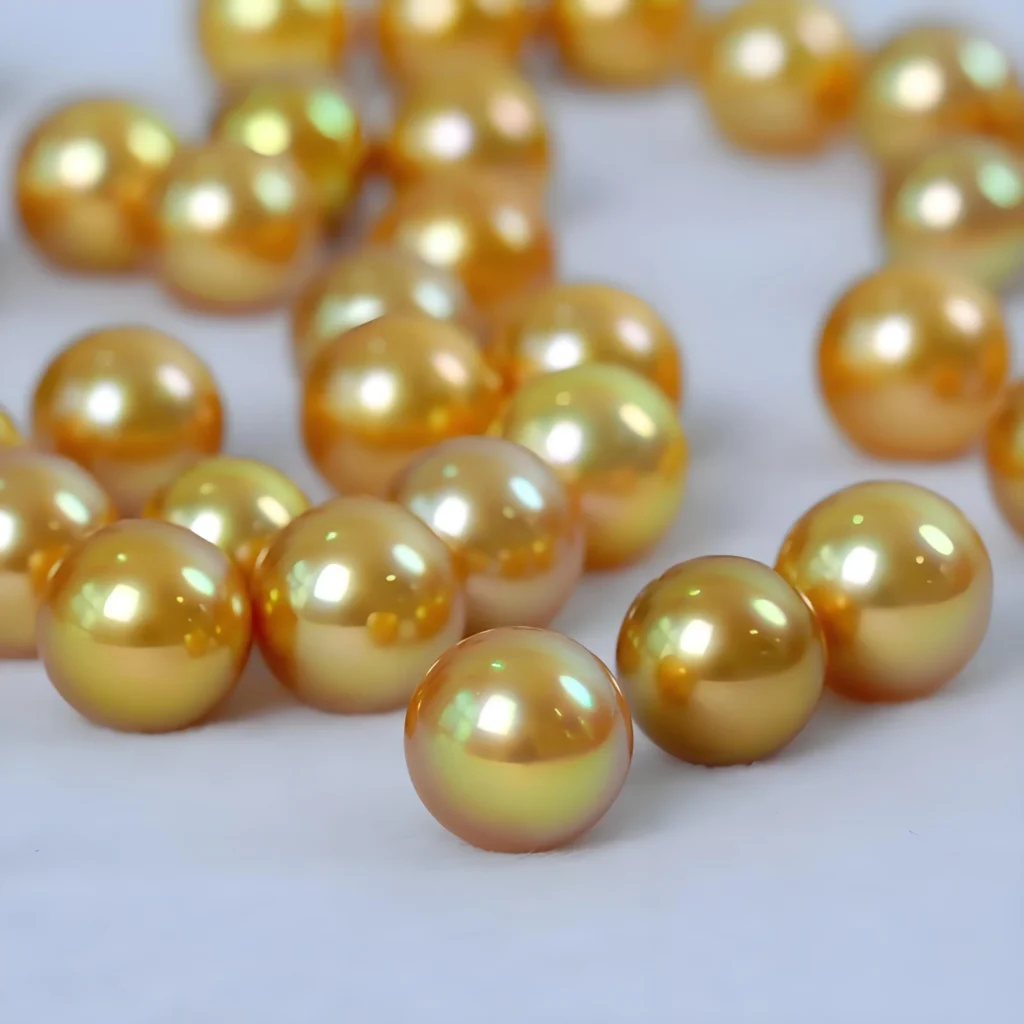
Most Expensive Pearl Type
Golden South Sea pearls are the most expensive, prized for their rarity, large size, and lustrous nacre. They are limited to golden-lipped oysters (Pinctada maxima) in pristine waters, and their thick nacre produces a soft, luxurious glow. A top-grade strand can fetch over $100,000; Tahitian black pearls and large Akoya pearls follow in value.
What Is the Highest Quality of Pearl
The “highest quality” pearl is subjective, as beauty often lies in the eye of the beholder. However, several factors universally define a pearl’s value: luster, nacre thickness, surface cleanliness, shape, size, and color.
Luster
Luster is often considered the most critical aspect of a pearl’s quality. The highest-grade pearls boast a mirror-like luster, reflecting light sharply and creating a vivid, bright appearance. This “silky luster” is particularly prized in white and gold South Sea pearls.
Surface Cleanliness
Top-quality pearls have few or no blemishes, bumps, or cracks. While minor imperfections may be acceptable, any significant flaws can greatly reduce the pearl’s value.
Shape
Shape also plays a role in determining a pearl’s quality. Perfectly round pearls are the rarest and most valuable, though unique shapes like baroque or keshi pearls have become trendy in modern design.
Size
A larger size of pearls generally means they are rarer and more valuable. South Sea pearls, for example, are generally larger than 15mm, and the price increases exponentially with each additional 1mm
Color
Saturated, even hues are preferred, with certain colors being particularly rare and valuable. Tahitian pearls with a deep peacock green hue or intense gold South Sea pearls are highly sought after.
Nacre Thickness
Nacre thickness is crucial, especially for saltwater pearls like Akoya and South Sea. Thick nacre ensures durability and a richer luster, while thin nacre can reduce the pearl’s value and longevity.
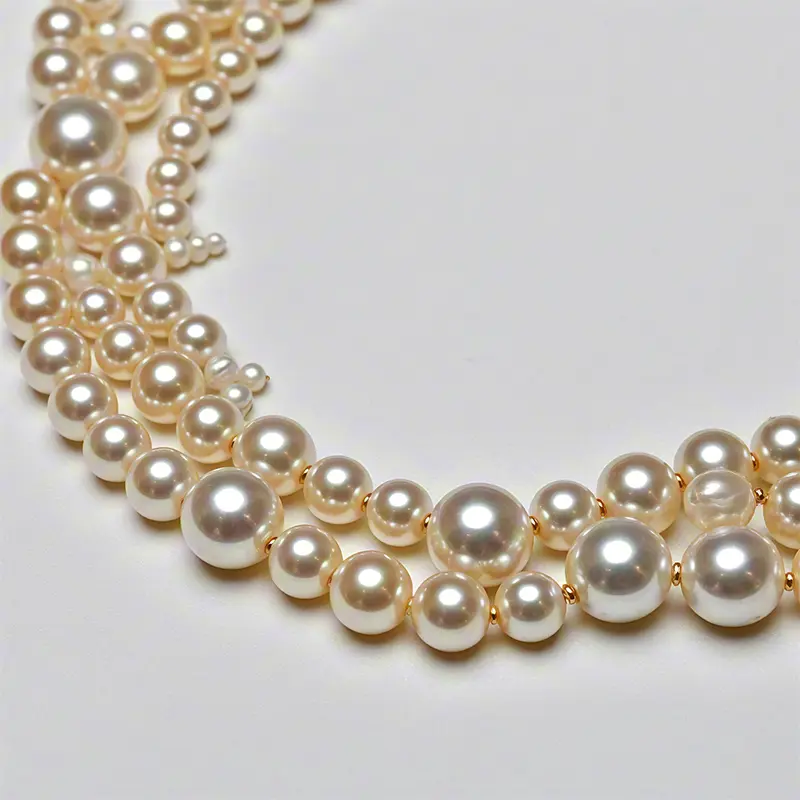
What Are Fake Pearls Called?
Fake pearls, often called “faux pearls” or “imitation pearls,” are man-made using materials like glass, plastic, or resin. They mimic natural pearls with pearlescent coatings but lack the depth and iridescence of real nacre. Types include shell pearls (crushed shells coated in resin), glass pearls (hollow beads dipped in pearlescent paint), plastic pearls (lightweight synthetic polymers with iridescent coatings), and controversial Mikimoto “Improved Cultured Pearls” (glass-core pearls coated with mother-of-pearl). While affordable, these imitations don’t match the organic allure of genuine pearls.
How to Tell If a Pearl Is Real?
We can distinguish real pearls from fakes through some simple tests. Jewelers use X-rays or microscopes to inspect nacre layers and differentiate between them for professional verification.
Tooth Test: Gently rub the pearl against your teeth. Real pearls feel gritty due to nacre layers, while faux pearls feel smooth.
Luster Check: Real pearls have a soft, deep glow, whereas imitations appear flat or overly shiny.
Magnifying glass observation: Real pearls have “growth lines” on the surface, while imitation pearls may show plastic or glass texture.
Temperature Test: Real pearls feel cool initially and warm gradually; plastic fakes feel warm immediately
Friction test: Friction between two real pearls will produce pearl powder, while imitation pearls may scratch the coating.
Do Real Pearls Turn Yellow?
Yes, real pearls can yellow over time due to nacre degradation from sweat or cosmetics, oxidation from air exposure, and thinning nacre revealing the bead nucleus in cultured pearls. To prevent yellowing, clean pearls with a soft cloth after wearing and store them in a breathable pouch away from direct sunlight, heat, and chemicals like perfumes or hairspray. Proper care helps maintain their natural luster and color.
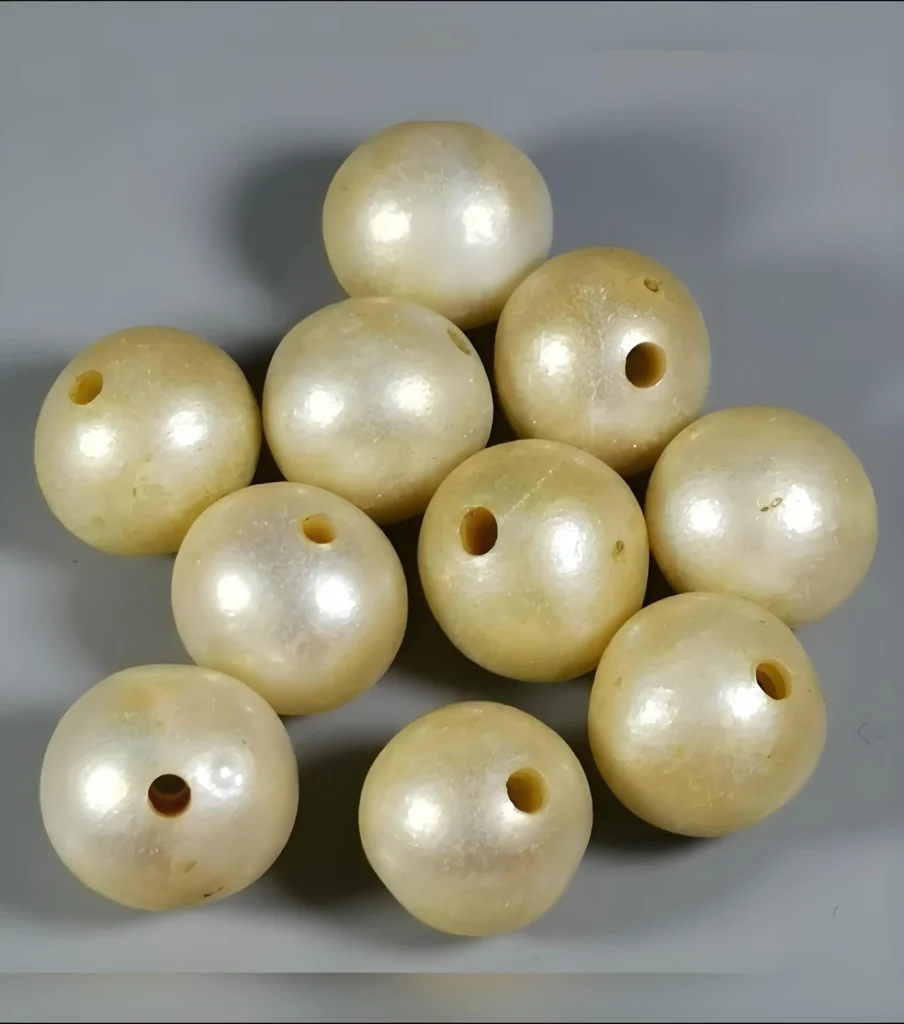
Why Are My Pearls Turning Grey?
Pearls may turn grey due to environmental factors like humidity, air pollutants, or contact with metals. Chemical exposure, such as to harsh cleaners or chlorine, can also strip the nacre’s iridescence. Additionally, low-quality nacre in cultured pearls may reveal a dark bead nucleus, creating a grey cast. To address greying, consider professional cleaning with pearl-safe solutions or re-nacre treatment for damaged pearls. Regular maintenance and avoiding harsh chemicals can help preserve their original hue.
The Takeaway
Understanding pearl types and quality empowers jewelers to design pieces that highlight the unique beauty of each gemstone, and selecting the right pearl will ensure your creations stand out in the competitive B2B market. For further insights, explore our curated collections or contact our team for custom OEM/ODM solutions tailored to your brand’s vision.

